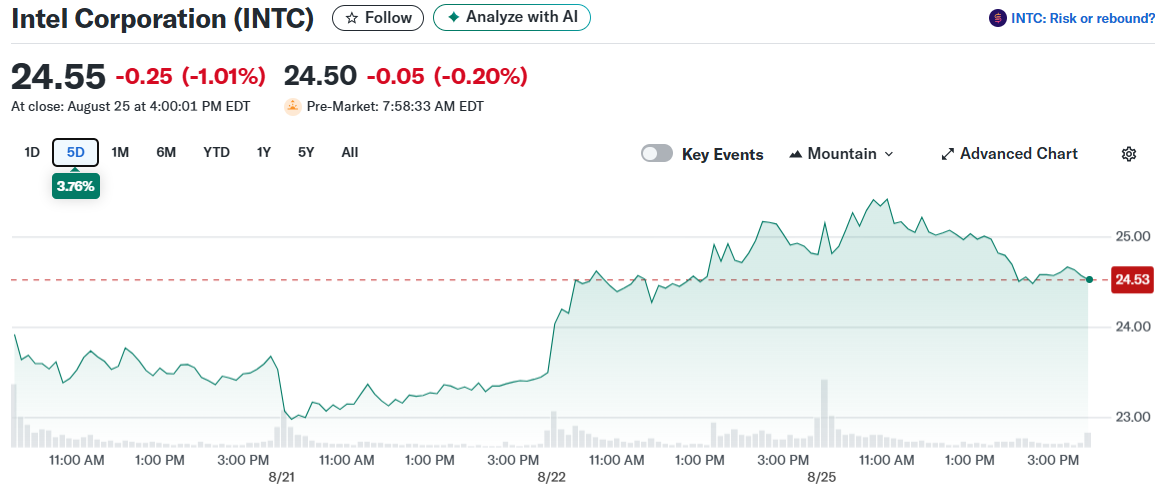TLDR
- Trump administration takes near 10% stake in Intel using $9 billion from Biden’s CHIPS Act funding
- Intel warns of potential “adverse reactions” from international customers and partners in SEC filing
- Analyst maintains Sell rating on Intel stock, citing $20 billion funding gap for manufacturing expansion
- Deal dilutes existing shareholders and gives government voting rights aligned with board decisions
- Intel stock has risen 25% in August but faces ongoing commercial challenges in chip manufacturing
Intel faces a complex situation as President Trump’s administration converts nearly $9 billion in CHIPS Act funding into a 10% equity stake in the company. The unprecedented move has sparked both market enthusiasm and analyst skepticism.

The deal emerged after Intel CEO Lip-Bu Tan was summoned to the White House earlier this month. Sen. Tom Cotton had raised concerns about Tan’s connections to Chinese state-owned businesses.
Trump celebrated the arrangement, claiming he “paid nothing” for the shares. He described it as “a great deal for America and also a great deal for Intel.”
Market Response and Analyst Concerns
Intel stock has climbed more than 18% since Tan’s White House meeting on August 11. The shares have gained nearly 25% for the month of August alone.
However, Jay Goldberg from Seaport Research Partners maintains a Sell rating on Intel stock. His price target of $18 sits 27% below Friday’s closing price.
Goldberg argues the government stake doesn’t address Intel’s core funding issues. He estimates the company needs at least another $20 billion to complete its 14A process technology development.
“The stake in Intel does nothing to shore up the company’s funding needs,” Goldberg wrote in a Monday research note. Without additional capital, he believes “the company’s future in semis manufacturing essentially comes to an end.”
International Business Risks
Intel warned of potential complications in a Monday SEC filing. The company highlighted concerns about “adverse reactions” from international stakeholders.
This worry carries weight given Intel’s global revenue structure. International sales accounted for 76% of Intel’s revenue in fiscal 2024, totaling $53.1 billion.
Foreign customers now face uncertainty about Intel’s connection to Trump’s tariff and trade policies. The company acknowledged potential negative reactions from “customers, suppliers, other business or commercial partners, foreign governments or competitors.”
The filing also noted risks from potential litigation and increased political scrutiny. Future political changes in Washington could challenge or void the current arrangement.
Shareholder Impact and Governance Changes
The deal creates immediate dilution for existing Intel shareholders. The Department of Commerce can acquire up to 433.3 million shares under the agreement.
Additional dilution could occur if the government exercises warrants linked to Intel’s foundry business. The company has not completed analysis of all “financial, tax and accounting implications.”
The government stake comes with specific voting arrangements. Commerce must vote alongside Intel’s board of directors on most matters.
However, the department can vote against any proposals that might unwind the deal. This structure “reduces the voting and other governance rights of stockholders,” according to the filing.
The arrangement also limits Intel’s flexibility for future transactions that might benefit shareholders. Any major corporate changes now require government approval.
Goldberg questions the legal framework supporting the share conversion. He suggests the deal might require congressional approval due to unclear legal mechanisms.
The government has not pledged additional support beyond unlocking existing CHIPS Act money. Governance questions remain unanswered after Trump said he “controls” Intel.
The most recent development shows Intel received $2.2 billion from the CHIPS program with another $5.7 billion pending. A separate federal program awarded $3.2 billion, bringing total government funding to $11.1 billion.


